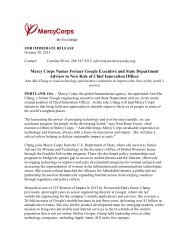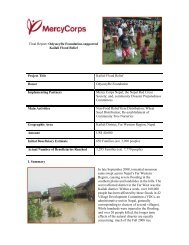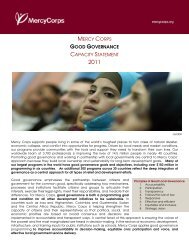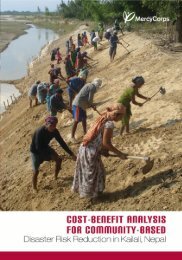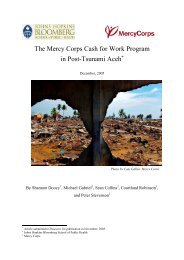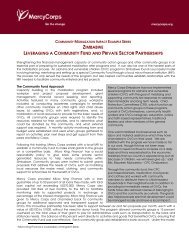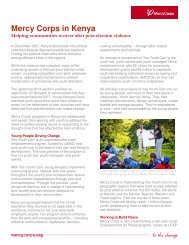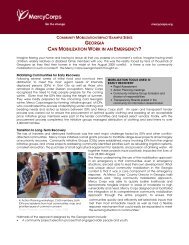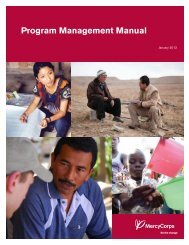SUSTAINABILITY FIELD STUDY - Mercy Corps
SUSTAINABILITY FIELD STUDY - Mercy Corps
SUSTAINABILITY FIELD STUDY - Mercy Corps
Create successful ePaper yourself
Turn your PDF publications into a flip-book with our unique Google optimized e-Paper software.
CAIP Helps Community Achieve Self-Governance“The CAIP program united people and enabled them to learn how to collect cash and solveproblems together.”— Tsoi Florida, Vice-Mayor, Kyzyl Kia, KyrgyzstanMashzavod neighborhood is recognized nationally for its success implementing self-initiatedprojects and is known throughout Kyzyl Kia Town as a model of successful self-governance thatcollaborates closely with the Central Administration for the overall development of the neighborhood.The synergy between CAIP and the Territorial Public Self-Government Program (TPSG)and their ability to successfully implement projects within Mashzavod serve as an example ofgovernment and an international organization collaborating for the sustained mobilization andpositive development of communities.The City Administration in Kyzyl Kia launched TPSG in 2003 in an effort to shift responsibilityfor the development of neighborhoods to the local level and better engage people in decisionmakingthat affects everyday life. At the same time the neighborhood of Mashzavod was engagingwith <strong>Mercy</strong> <strong>Corps</strong>’ and achieved exceptional success in self-governance, in part because ofthe complementary and opportune timing of the community’s work with CAIP.TPSG works closely with the city administration, which provides ongoing financial, technical andmentoring support to community leaders elected through community meetings. The original headof the TPSG in Mashzavod, Gulyam Kazakov, was also a member of the CAG and is credited bythe Central Administration and peers in the community for a good deal of the neighborhood’ssuccess.Mr. Kazakov also feels his experience with <strong>Mercy</strong> <strong>Corps</strong> helped the community get started onthe right foot. “The seminars and trainings helped us, as TPSG leaders, to develop managerialabilities and be more active in our work with community members. Because of CAIP, peoplespoke more openly about their problems, were more active, and participated in general meetings.Our great advantage was that CAIP started work almost at the same time when TPSGwas organizing in the communities of our town. Success factors of TPSG included highly activepeople; trust established through successful CAIP projects, especially after realization of thefirst project; installation of a new transformer; and motivated CAG members and TPSG leaders.”The current head of TPSG in Mashzavod confirms, “If CAIP did not work in Mashzavod, thenpeople would certainly have a different attitude toward TPSG. People’s belief in self-governancestrengthened when they saw that projects work.”2. Transparency & Accountability.PCI and CAIP promoted transparency and accountability through a variety of methods, includingtransparency boards showing project budgets and CAG member names, frequent community meetingsand careful tracking of community contributions and financial expenditures. While the study foundfew transparency boards still in use for their intended purpose, there was evidence that accountabilitymechanisms were in place in a number of communities.Access to InformationOf the government representatives interviewed, 54% stated that the whole community has access togovernment records about meetings or agreements with communities. At the community level, 62% ofUnderstanding What Promotes Lasting Change at the Community Level27



